7 Piece Endgame Database
Wyllie Draughts is equipped with endgame databases for all endings with a total of 7
or fewer pieces, as well as several 4 v 4 endings. These endgame databases enable it to solve
many classic endgames such as Strickland's Position
for example, that are beyond most other programs' capabilities. They can also enable the
program to correctly see when to trade down in into a 7 piece ending.
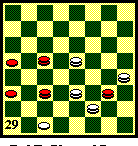 The diagram on the left shows a position reached in game between two World Champion players,
Newell Banks v Alfred Jordan. White (Banks) played the losing 27-32? in this position.
Given the Red pieces, Wyllie Draughts instantly announces a win and plays 22-26,
20x27, 26x10 into a winning 4 v 3 ending. Jordan did indeed play this, and duely won. The
ending is an example of Fourth Position, a standard endgame where the result hinges on whose
turn it is to move. Instead of 27-32, given the White pieces, Wyllie Draughts
immediately finds the moves Banks should have played: 15-18!, 22x15* (24x31, 18x9
is a White win), 27-31, 24-28, 23-19, 15x24, 20x27 into a drawing 4 v 3 ending.
The diagram on the left shows a position reached in game between two World Champion players,
Newell Banks v Alfred Jordan. White (Banks) played the losing 27-32? in this position.
Given the Red pieces, Wyllie Draughts instantly announces a win and plays 22-26,
20x27, 26x10 into a winning 4 v 3 ending. Jordan did indeed play this, and duely won. The
ending is an example of Fourth Position, a standard endgame where the result hinges on whose
turn it is to move. Instead of 27-32, given the White pieces, Wyllie Draughts
immediately finds the moves Banks should have played: 15-18!, 22x15* (24x31, 18x9
is a White win), 27-31, 24-28, 23-19, 15x24, 20x27 into a drawing 4 v 3 ending.
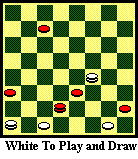 The diagram on the right is even more interesting. It occured in a game between the
great Sam Gonotsky and John Bradford in an effort to determine
if a "cook" sprung on the US team at the International Match by the British team could
draw a weak opening that had previously been thought to lose. Gonotsky (White) is to play.
Although White is a piece down, his positional superiority is sufficient to draw, but the
ending is extremely difficult to solve correctly, both for humans and computers! He played
the plausible but losing move 19-24, but given this position Wyllie Draughts
immediately sees a draw and finds the correct moves for White:- 19-15*, 6-9, 15-18*, 26-31,
18x27, 31x24, 29-25* into a drawing 4 v 3 database ending. After the losing 19-24, as played
by Gonotsky in the game, Bradford continued with the winning 26-31*, 24-20, 6-10, 20-16, 31-26,
16-20, 26-22, 20-24, 10-15, 24-20, but now he went wrong with 15-18?, which allows a draw! This draw that was
missed by Gonotsky has never before been pointed out. He played the correct 20-16, 21-25!, 30x21, 23-26, but then
played the losing move 32-27?, allowing Bradford to win by 26-31, 27-24, 31-27, 24-19, 18-23,
19-15, etc. Instead of 32-27?, Wyllie Draughts finds the draw that Gonotsky missed:-
16-19!, 23-26, and now either
The diagram on the right is even more interesting. It occured in a game between the
great Sam Gonotsky and John Bradford in an effort to determine
if a "cook" sprung on the US team at the International Match by the British team could
draw a weak opening that had previously been thought to lose. Gonotsky (White) is to play.
Although White is a piece down, his positional superiority is sufficient to draw, but the
ending is extremely difficult to solve correctly, both for humans and computers! He played
the plausible but losing move 19-24, but given this position Wyllie Draughts
immediately sees a draw and finds the correct moves for White:- 19-15*, 6-9, 15-18*, 26-31,
18x27, 31x24, 29-25* into a drawing 4 v 3 database ending. After the losing 19-24, as played
by Gonotsky in the game, Bradford continued with the winning 26-31*, 24-20, 6-10, 20-16, 31-26,
16-20, 26-22, 20-24, 10-15, 24-20, but now he went wrong with 15-18?, which allows a draw! This draw that was
missed by Gonotsky has never before been pointed out. He played the correct 20-16, 21-25!, 30x21, 23-26, but then
played the losing move 32-27?, allowing Bradford to win by 26-31, 27-24, 31-27, 24-19, 18-23,
19-15, etc. Instead of 32-27?, Wyllie Draughts finds the draw that Gonotsky missed:-
16-19!, 23-26, and now either
A) 26-30 , 19-24*, 18-23, 21-17!*, 22x13, 24-27* into a drawing 4 v 3 database position, or
B) 26-31, 19-16, 18-23, 21-17!* 22x13, 29-25* again into a a drawing 4 v 3 database position.
So what should Bradford have played instead of 15-18?, allowing this Wyllie draw?
Wyllie finds 21-25*, 30x21,23-26, 20-16, 26-30, 16-20, 30-26* (C,D), 20-24, 26-23* (E),
24-27, 23-18*, 27-31 (27-24? 15-19 wins), 18-14, 31-27, 15-19, 27-31 (27-24?, 14-18 wins),
19-23, 31-27, 23-26, 27-24 (or 27-31), 26-30, 24-27, 30-26, 27-24 (F), 14-18, and Red wins.
C) 15-18?, 20-24, 18-23, 24-27, 23-26, 21-17* 22x13, 27-31 draws.
D) 15-19?, 21-17*, 22x17, 20-24*, 19-23, 24-27*, 23-26, 27-31* draws
E) 15-18? 24-20, 18-23 (26-23, 20-16 draws), 20-24, 26-31, 21-17*, 22x13, 29-25* into a 4 v 3 database draw.
F) 27-31, 26-23,31-27, 23-29, 27-24 (27-31?, 19-24 wins), 14-18, 24x15, 18x11 wins by
first position.
The fact that both Gonotsky and Bradford misplayed this ending is a testament to it's difficulty. The need to bring the
second red king to 14 before crowning the third king has to be seen, and this in turn requires that the man-down draw
with a timely 21-17 pitch must be foreseen. A fine example of what the 7-piece endgame database can do.
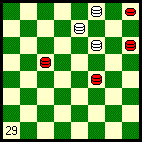 This is a standard endgame known as the Mars position, with Red to play and win. Again
Wyllie Draughts has no difficulty winning this database position while moving instantly
on each turn: 19-23, 11-15, 23-26, 15-11, 26-22, 7-2, 14-10, 2-7, 10-6, 7-2,
6-9, 2-7, 22-17, 7-2, 17-13, 2-7, 9-6, 7-2, 4-8, 11-4, 12-16, 2-9, 13-6,
4-8, 6-10 RW
This is a standard endgame known as the Mars position, with Red to play and win. Again
Wyllie Draughts has no difficulty winning this database position while moving instantly
on each turn: 19-23, 11-15, 23-26, 15-11, 26-22, 7-2, 14-10, 2-7, 10-6, 7-2,
6-9, 2-7, 22-17, 7-2, 17-13, 2-7, 9-6, 7-2, 4-8, 11-4, 12-16, 2-9, 13-6,
4-8, 6-10 RW
Some Man-Down Draws
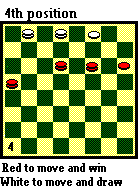 This is the most well known 4 v 3 draw, known as Fourth Position. It causes great difficulty
for programs that do not have 7 piece databases. The following "descriptive analysis" by Al
Lyman is a good explanation for human minds.
Let us examine the battlefield, beyond what is obvious. White is a man down. Red has the attack, but also has
the "held" piece on square 21, being held by the White piece on 30. In this case the position is a Red Win-but
only because, Red has the move! In these kind of man down endings, (very common) the Master players
simply "man off" the pieces-that is the active pieces-and may disregard the 2 pieces out of play. One is held,
and the other, though holding, is also held-by circumstance. If you "mask the dead duck on 21", or simply pretend it is not
even on the board, and make your count with the "Active" pieces, we find we have equal pieces, and can do the move count
in the normal fashion. With Red to play, we look from square 4, at the top right, and continue counting the pieces in the Red
system. There is only 1. The king on 20. An "odd" number. Therefore Red has the move, and can win. I assure you if it is
"Whites turn to play" we again mask the dead piece on 21, and find, counting from the white side, 5 pieces in the white
system. With white to play-"white has the move", and the game is a draw, and cannot be won. 4th position wins, "If" you
have the move, and draws, otherwise. The same applies to 1st position and 2nd position.
The drawing version is quite simple. All one has to do is "twitch" the king on 31, to and fro, until the moment of
truth. Go 31-27, 22-18, 27-31, 23-19, 31-27, 19-24, 27-31, 18-23, and 31-26*, and the attackers cannot make any
headway, nor force an exchange. Drawn. The winning version is quite neat, remembering that forcing trades, or
the reduction of pieces is necessary. Go 22-18, 31-27, 23-19, 27-31, 19-24, 32-27, (31-26, 24-28 same. Or 32-28,
24-27 gets the exchange) 24-28, 27-32, 18-22, 31-27 and the key 22-26, 30-23, 28-24 wins. An elegant "indirect" trade!
Red Wins.
This is the most well known 4 v 3 draw, known as Fourth Position. It causes great difficulty
for programs that do not have 7 piece databases. The following "descriptive analysis" by Al
Lyman is a good explanation for human minds.
Let us examine the battlefield, beyond what is obvious. White is a man down. Red has the attack, but also has
the "held" piece on square 21, being held by the White piece on 30. In this case the position is a Red Win-but
only because, Red has the move! In these kind of man down endings, (very common) the Master players
simply "man off" the pieces-that is the active pieces-and may disregard the 2 pieces out of play. One is held,
and the other, though holding, is also held-by circumstance. If you "mask the dead duck on 21", or simply pretend it is not
even on the board, and make your count with the "Active" pieces, we find we have equal pieces, and can do the move count
in the normal fashion. With Red to play, we look from square 4, at the top right, and continue counting the pieces in the Red
system. There is only 1. The king on 20. An "odd" number. Therefore Red has the move, and can win. I assure you if it is
"Whites turn to play" we again mask the dead piece on 21, and find, counting from the white side, 5 pieces in the white
system. With white to play-"white has the move", and the game is a draw, and cannot be won. 4th position wins, "If" you
have the move, and draws, otherwise. The same applies to 1st position and 2nd position.
The drawing version is quite simple. All one has to do is "twitch" the king on 31, to and fro, until the moment of
truth. Go 31-27, 22-18, 27-31, 23-19, 31-27, 19-24, 27-31, 18-23, and 31-26*, and the attackers cannot make any
headway, nor force an exchange. Drawn. The winning version is quite neat, remembering that forcing trades, or
the reduction of pieces is necessary. Go 22-18, 31-27, 23-19, 27-31, 19-24, 32-27, (31-26, 24-28 same. Or 32-28,
24-27 gets the exchange) 24-28, 27-32, 18-22, 31-27 and the key 22-26, 30-23, 28-24 wins. An elegant "indirect" trade!
Red Wins.
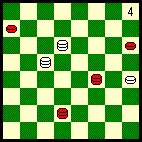 It is surprising how many drawn 4 v 3 endings there are! This is McCulloch's Draw, a well
known man-down ending, presented here with White to move. Of course Wyllie Draughts
recognises this as a draw immediately. The continuation from the diagram is
14-17, 26-23, 17-14, 19-24, 10-15, 23-19, 15-10, 24-27, 14-17, 27-23, 17-14
Draw
It is surprising how many drawn 4 v 3 endings there are! This is McCulloch's Draw, a well
known man-down ending, presented here with White to move. Of course Wyllie Draughts
recognises this as a draw immediately. The continuation from the diagram is
14-17, 26-23, 17-14, 19-24, 10-15, 23-19, 15-10, 24-27, 14-17, 27-23, 17-14
Draw
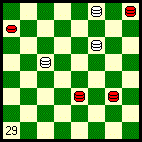 Another man-down draw known as Barker's Triangle, again with White to play.
These positions are frustrating for the man-up side, but a correct
assessment of them can enable Wyllie Draughts to pull off some neat
escapes. From the diagram 3-8, 24-20, 8-12, 23-19, 11-7, 20-16, 7-2, 16-11,
12-8, 19-15, 8-12 Draw
Another man-down draw known as Barker's Triangle, again with White to play.
These positions are frustrating for the man-up side, but a correct
assessment of them can enable Wyllie Draughts to pull off some neat
escapes. From the diagram 3-8, 24-20, 8-12, 23-19, 11-7, 20-16, 7-2, 16-11,
12-8, 19-15, 8-12 Draw
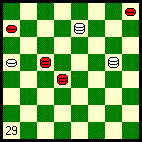 This is another famous man-down escape known as Miller's Draw, presented with White to move.
Continue from the diagram :
16-11, 14-17, 7-10, 18-14, 10-7, 17-22, 11-16, 22-18, 16-11, 18-23, 11-16,
14-18, 7-10, 23-27, 16-11, 27-24, 11-16, 18-23, 16-11, 24-20, 10-7, 23-18,
7-10 Draw
This is another famous man-down escape known as Miller's Draw, presented with White to move.
Continue from the diagram :
16-11, 14-17, 7-10, 18-14, 10-7, 17-22, 11-16, 22-18, 16-11, 18-23, 11-16,
14-18, 7-10, 23-27, 16-11, 27-24, 11-16, 18-23, 16-11, 24-20, 10-7, 23-18,
7-10 Draw
 The diagram on the left shows a position reached in game between two World Champion players,
Newell Banks v Alfred Jordan. White (Banks) played the losing 27-32? in this position.
Given the Red pieces, Wyllie Draughts instantly announces a win and plays 22-26,
20x27, 26x10 into a winning 4 v 3 ending. Jordan did indeed play this, and duely won. The
ending is an example of Fourth Position, a standard endgame where the result hinges on whose
turn it is to move. Instead of 27-32, given the White pieces, Wyllie Draughts
immediately finds the moves Banks should have played: 15-18!, 22x15* (24x31, 18x9
is a White win), 27-31, 24-28, 23-19, 15x24, 20x27 into a drawing 4 v 3 ending.
The diagram on the left shows a position reached in game between two World Champion players,
Newell Banks v Alfred Jordan. White (Banks) played the losing 27-32? in this position.
Given the Red pieces, Wyllie Draughts instantly announces a win and plays 22-26,
20x27, 26x10 into a winning 4 v 3 ending. Jordan did indeed play this, and duely won. The
ending is an example of Fourth Position, a standard endgame where the result hinges on whose
turn it is to move. Instead of 27-32, given the White pieces, Wyllie Draughts
immediately finds the moves Banks should have played: 15-18!, 22x15* (24x31, 18x9
is a White win), 27-31, 24-28, 23-19, 15x24, 20x27 into a drawing 4 v 3 ending.
 The diagram on the right is even more interesting. It occured in a game between the
great
The diagram on the right is even more interesting. It occured in a game between the
great  This is a standard endgame known as the Mars position, with Red to play and win. Again
Wyllie Draughts has no difficulty winning this database position while moving instantly
on each turn: 19-23, 11-15, 23-26, 15-11, 26-22, 7-2, 14-10, 2-7, 10-6, 7-2,
6-9, 2-7, 22-17, 7-2, 17-13, 2-7, 9-6, 7-2, 4-8, 11-4, 12-16, 2-9, 13-6,
4-8, 6-10 RW
This is a standard endgame known as the Mars position, with Red to play and win. Again
Wyllie Draughts has no difficulty winning this database position while moving instantly
on each turn: 19-23, 11-15, 23-26, 15-11, 26-22, 7-2, 14-10, 2-7, 10-6, 7-2,
6-9, 2-7, 22-17, 7-2, 17-13, 2-7, 9-6, 7-2, 4-8, 11-4, 12-16, 2-9, 13-6,
4-8, 6-10 RW
 This is the most well known 4 v 3 draw, known as Fourth Position. It causes great difficulty
for programs that do not have 7 piece databases. The following "descriptive analysis" by Al
Lyman is a good explanation for human minds.
Let us examine the battlefield, beyond what is obvious. White is a man down. Red has the attack, but also has
the "held" piece on square 21, being held by the White piece on 30. In this case the position is a Red Win-but
only because, Red has the move! In these kind of man down endings, (very common) the Master players
simply "man off" the pieces-that is the active pieces-and may disregard the 2 pieces out of play. One is held,
and the other, though holding, is also held-by circumstance. If you "mask the dead duck on 21", or simply pretend it is not
even on the board, and make your count with the "Active" pieces, we find we have equal pieces, and can do the move count
in the normal fashion. With Red to play, we look from square 4, at the top right, and continue counting the pieces in the Red
system. There is only 1. The king on 20. An "odd" number. Therefore Red has the move, and can win. I assure you if it is
"Whites turn to play" we again mask the dead piece on 21, and find, counting from the white side, 5 pieces in the white
system. With white to play-"white has the move", and the game is a draw, and cannot be won. 4th position wins, "If" you
have the move, and draws, otherwise. The same applies to 1st position and 2nd position.
The drawing version is quite simple. All one has to do is "twitch" the king on 31, to and fro, until the moment of
truth. Go 31-27, 22-18, 27-31, 23-19, 31-27, 19-24, 27-31, 18-23, and 31-26*, and the attackers cannot make any
headway, nor force an exchange. Drawn. The winning version is quite neat, remembering that forcing trades, or
the reduction of pieces is necessary. Go 22-18, 31-27, 23-19, 27-31, 19-24, 32-27, (31-26, 24-28 same. Or 32-28,
24-27 gets the exchange) 24-28, 27-32, 18-22, 31-27 and the key 22-26, 30-23, 28-24 wins. An elegant "indirect" trade!
Red Wins.
This is the most well known 4 v 3 draw, known as Fourth Position. It causes great difficulty
for programs that do not have 7 piece databases. The following "descriptive analysis" by Al
Lyman is a good explanation for human minds.
Let us examine the battlefield, beyond what is obvious. White is a man down. Red has the attack, but also has
the "held" piece on square 21, being held by the White piece on 30. In this case the position is a Red Win-but
only because, Red has the move! In these kind of man down endings, (very common) the Master players
simply "man off" the pieces-that is the active pieces-and may disregard the 2 pieces out of play. One is held,
and the other, though holding, is also held-by circumstance. If you "mask the dead duck on 21", or simply pretend it is not
even on the board, and make your count with the "Active" pieces, we find we have equal pieces, and can do the move count
in the normal fashion. With Red to play, we look from square 4, at the top right, and continue counting the pieces in the Red
system. There is only 1. The king on 20. An "odd" number. Therefore Red has the move, and can win. I assure you if it is
"Whites turn to play" we again mask the dead piece on 21, and find, counting from the white side, 5 pieces in the white
system. With white to play-"white has the move", and the game is a draw, and cannot be won. 4th position wins, "If" you
have the move, and draws, otherwise. The same applies to 1st position and 2nd position.
The drawing version is quite simple. All one has to do is "twitch" the king on 31, to and fro, until the moment of
truth. Go 31-27, 22-18, 27-31, 23-19, 31-27, 19-24, 27-31, 18-23, and 31-26*, and the attackers cannot make any
headway, nor force an exchange. Drawn. The winning version is quite neat, remembering that forcing trades, or
the reduction of pieces is necessary. Go 22-18, 31-27, 23-19, 27-31, 19-24, 32-27, (31-26, 24-28 same. Or 32-28,
24-27 gets the exchange) 24-28, 27-32, 18-22, 31-27 and the key 22-26, 30-23, 28-24 wins. An elegant "indirect" trade!
Red Wins.
 It is surprising how many drawn 4 v 3 endings there are! This is McCulloch's Draw, a well
known man-down ending, presented here with White to move. Of course Wyllie Draughts
recognises this as a draw immediately. The continuation from the diagram is
14-17, 26-23, 17-14, 19-24, 10-15, 23-19, 15-10, 24-27, 14-17, 27-23, 17-14
Draw
It is surprising how many drawn 4 v 3 endings there are! This is McCulloch's Draw, a well
known man-down ending, presented here with White to move. Of course Wyllie Draughts
recognises this as a draw immediately. The continuation from the diagram is
14-17, 26-23, 17-14, 19-24, 10-15, 23-19, 15-10, 24-27, 14-17, 27-23, 17-14
Draw
 Another man-down draw known as Barker's Triangle, again with White to play.
These positions are frustrating for the man-up side, but a correct
assessment of them can enable Wyllie Draughts to pull off some neat
escapes. From the diagram 3-8, 24-20, 8-12, 23-19, 11-7, 20-16, 7-2, 16-11,
12-8, 19-15, 8-12 Draw
Another man-down draw known as Barker's Triangle, again with White to play.
These positions are frustrating for the man-up side, but a correct
assessment of them can enable Wyllie Draughts to pull off some neat
escapes. From the diagram 3-8, 24-20, 8-12, 23-19, 11-7, 20-16, 7-2, 16-11,
12-8, 19-15, 8-12 Draw
 This is another famous man-down escape known as Miller's Draw, presented with White to move.
Continue from the diagram :
16-11, 14-17, 7-10, 18-14, 10-7, 17-22, 11-16, 22-18, 16-11, 18-23, 11-16,
14-18, 7-10, 23-27, 16-11, 27-24, 11-16, 18-23, 16-11, 24-20, 10-7, 23-18,
7-10 Draw
This is another famous man-down escape known as Miller's Draw, presented with White to move.
Continue from the diagram :
16-11, 14-17, 7-10, 18-14, 10-7, 17-22, 11-16, 22-18, 16-11, 18-23, 11-16,
14-18, 7-10, 23-27, 16-11, 27-24, 11-16, 18-23, 16-11, 24-20, 10-7, 23-18,
7-10 Draw